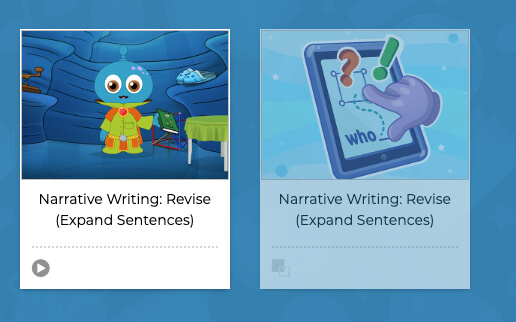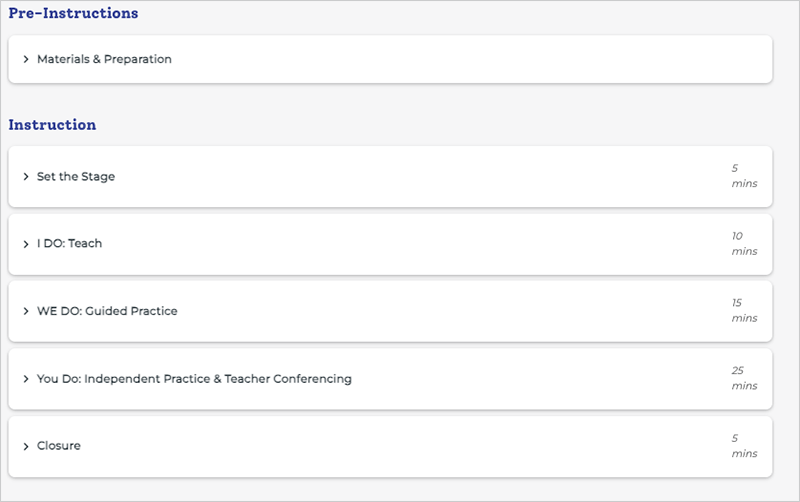Writing A-Z® is an evidence-based and standards-aligned, integrated approach to teaching writing for K-5 from Learning A-Z®. This digital program weaves opinion, informative, and narrative genre instruction together with the writing process. As children progress from kindergarten through grade five, writing composition skills are built systematically from easier to more complex.
Evidence-Aligned Program
Students need to learn the writing process, and receive explicit strategy instruction. Writing A-Z streamlines this integrated approach well, with minimal prep time for the teacher. For example, each lesson includes standards and objectives as well as explicit modeling videos to introduce writing concepts. Scripted lessons can be printed or assigned to students, and assessments are built into the program.
Writing A-Z is set up in alignment with the gradual release model of instruction, where the teacher models (I Do), practices together with students (We Do), and then students are given an opportunity to independently apply what they have learned (You Do). I particularly love the I Do instructional videos because they take the heavy lift off the teacher. If I were short on time, I wouldn’t have to worry because the instructional videos are there for me to use in every lesson. The videos are engaging, with fun characters who teach writing concepts and important vocabulary terms.

“Students need explicit strategy instruction as well as to be taught the writing process, and Writing A-Z does a great job at streamlining this integrated approach with minimal prep time for the teacher.”
The research on effective literacy instruction indicates that proficiency in literacy doesn't result just from learning to read. Literacy is attained through both reading AND writing, and Writing A-Z provides this often-missing, critical component of a strong English Language Arts (ELA) block.
The research and rationale behind Writing A-Z states:
“Today's teachers are expected to adapt their literacy instruction to include scientifically based practices such as the Science of Reading (SoR). However, literacy is not achieved through reading alone.
Research shows that students' reading comprehension improves when they also spend more time writing. This does not mean writing should be taught only in response to reading a text, however.
Students need explicit instruction in foundational writing skills and strategies in order to communicate their ideas as well as to understand a text. The future path of learning must include explicit evidence-based writing instruction.”
Many packaged programs in the literacy world label themselves as research-based when they aren’t, but I can confidently say that Writing A-Z is an evidence-aligned program. Below I have cited research (Graham & Perin, 2007; Coker & Lewis, 2008) and included the ways that Writing A-Z honors that body of research in their program:
- Explicit instruction in strategies for planning, revising, and editing: Each module for every grade level guides students with explicit instruction through the writing process (plan, draft, revise, edit, publish).
- Group work focusing on the steps of the writing process: Each lesson in Writing A-Z includes group work where students collaborate on different aspects of the writing process.
- Specification of concrete, achievable goals for student writing: Each lesson includes goal setting with students for revision, as well as a professional development video for teachers on the importance and best practices for setting student goals.
- Use of word-processing equipment during the writing process: Students use WaLT (Writing and Learning Together, the digital writing notebook within Writing A-Z), digital graphic organizers, and the writing notebook to draft and create their writing pieces.
- Explicit instruction combining simple sentences into more complex sentences: Although lessons are structured under the umbrella of the writing process, each module includes a lesson on sentence-level work where students learn how to combine or expand sentences.
- Participation in various planning techniques before composing: In each unit, the writing process begins with planning. Strategies include narrowing topics, using graphic organizers, brainstorming, developing reasons and supporting details, and more.
Versatility—The Program's Best Quality
While I appreciate the program’s compliance with the research, as a literacy coach whose job it is to make a classroom teacher’s life easier, I believe the best part of this program is its versatility.
Writing A-Z can be used as a standalone writing program or a supplement to your current approach to writing instruction. If you use it as a standalone, you can teach the lessons in order. If you use it as a supplement, you can explore the platform’s Collections which include printable resources such as graphic organizers or student self-assessment checklists. The collections also include Writing Packs, which have an introduction video that models a writing concept or strategy, as well as an assessment check that students can complete independently.

"I believe the best part of this program (like all of Learning A-Z’s programs) is its versatility."
For example, if you are teaching sentence expansion, you can type “sentence expansion” into the search bar and several Writing Packs will populate for that specific skill. You can assign a writing pack that teaches and assesses that skill for students to complete on their own. You can also assign lessons to reinforce what you are already teaching. If students are on your roster, they will receive the assignment and can complete it independently at a learning center while you teach small groups.
An Area of Improvement
Writing A-Z clearly states that they do not teach transcription skills—handwriting or typing. Students need these skills to build the automaticity needed for skillful composition and won’t be able to complete this program without frustration if they don’t have proficient typing and handwriting skills. I understand that this is not the purpose of the program, but these skills need to be in place so that students’ cognitive energy can be devoted to composing, which is what Writing A-Z primarily focuses on.

WaLT (Writing and Learning Together)
WaLT (Writing and Learning Together) is the digital writing notebook that teachers can use to model effective writing for students. Students also use WaLT to complete each step of the writing process digitally (grades two through five). I love WaLT because it is the same for the teacher and students, which provides consistency for students as they practice independently what they have learned from the teacher. In WaLT, after the teacher models the writing process, students can practice independently completing a graphic organizer and jotting down ideas in their writer’s notebook.
The Lessons
For every grade level, there are four units, five modules, and five lessons. The units can be taught in different order, but the modules cannot because each follows the writing process and should be taught accordingly.
Each lesson is structured as follows:
- Set the Stage
- I Do
- We Do
- You Do
- Closure

If you are using Foundations A-Z® as well, this structure will be familiar to your students. Each lesson is designed to take 45-60 minutes, but in my opinion, the lessons could be done in 30 minutes. Below I have shared my thoughts on some of the components from a few modules:
Grade K Unit 2 Module 2 Lesson 1
In this lesson, a fun animated character explicitly models an opinion, topic, purpose, and audience. My initial thought was, “Will kindergartners retain four vocabulary terms in one lesson?” The character makes the lesson engaging, so I believe it is possible, but students would likely need a cumulative review of these terms in later lessons. The character also reviews what he teaches at the end of the video, which I appreciate because it reiterates what we want our students to know—an important pillar of explicit instruction. Students can then play a game to check for their understanding (yay for a formative assessment). I love the videos for the modeling portion because explicit modeling can be challenging for teachers. The videos keep teachers focused and on time.
Grade K Unit 2 Module 3 “You Do” Directions
Something to keep in mind is that although the program is intended to be comprehensive, the teacher will have to find and prep a few materials for each lesson, like photos and objects as examples. Teachers never have enough time, so this is something to consider if you’re using the program.
In Summary: It’s Versatile, Research-Aligned, and Saves Teachers Time
Writing A-Z is truly a research-aligned and integrated approach to teaching writing that streamlines planning for teachers with built-in support that saves time. While there is a lack of transcription skills instruction, overall it is an explicit and comprehensive approach that can be used as a standalone writing program or a supplement to your current approach to teaching writing.
Try Writing A-Z in Your Classroom
Experience for yourself how this award-winning K-5 writing solution can simplify instructional planning and improve student outcomes.
References:
- Graham, Steve, and Dolores Perin. WRITING next EFFECTIVE STRATEGIES to IMPROVE WRITING of ADOLESCENTS in MIDDLE and HIGH SCHOOLS a Report to Carnegie Corporation of New York. 2007, media.carnegie.org/filer_public/3c/f5/3cf58727-34f4-4140-a014-723a00ac56f7/ccny_report_2007_writing.pdf.
- COKER, DAVID, and WILLIAM LEWIS. “BeyondWriting Next:A Discussion of Writing Research and Instructional Uncertainty.” Harvard Educational Review, vol. 78, no. 1, Apr. 2008, pp. 231–51, https://doi.org/10.17763/haer.78.1.275qt3622200317h.


